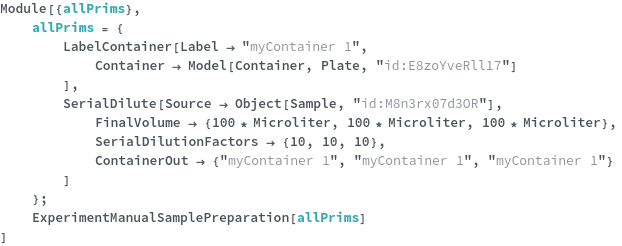SerialDilute
SerialDilute[Options]⟹UnitOperation
transfers an amount of sample into a container and dilutes it with buffers as specified.
A serial dilution involves taking a liquid sample and diluting it multiple times by a dilution factor into separate containers. It starts with the concentrated sample and multiple containers with the same amount of diluent. A certain amount of concentrated sample is transferred to one of these containers, and from this container, the same amount is transferred to another container. This process is repeated until the desired number of dilutions has been made. An example is performing a series of ten-fold dilutions; 1mL of concentrated sample can be transferred to a tube containing 9mL of diluent, then 1mL from this dilution would be transferred into another tube with 9mL of diluent, and so on.
Experimental Principles
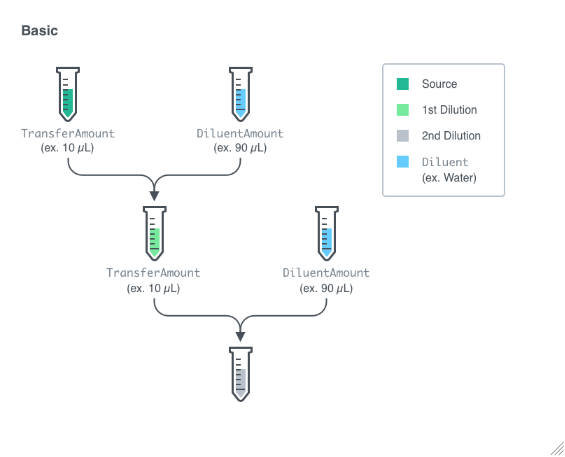
Figure 1.1: A specified or calculated amount is transferred from the input sample to a container with specified or calculated amounts of Diluent. After mixing, another amount is transferred from the second container to a third container, where the buffer is diluted again with a Diluent. In this example, the source sample is being diluted by factors of 10 two times in a water Diluent.
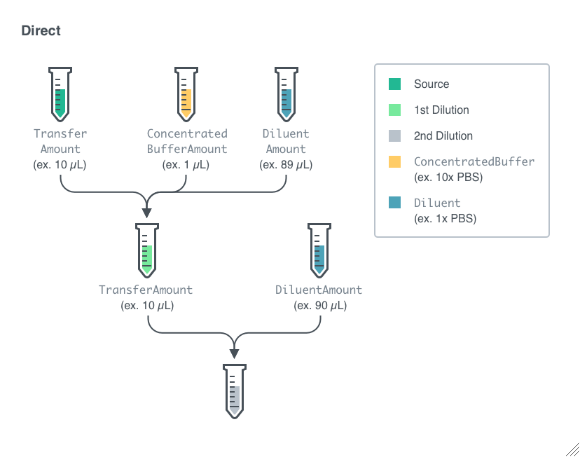
Figure 1.2: A specified or calculated amount is transferred from the input sample to a container with specified or calculated amounts of Diluent, and optionally, a ConcentratedBuffer. After mixing, another amount is transferred from the second container to a third container with a specified amount of Diluent, and the process repeats until the desired number of dilutions is reached. In this example, the sample is being diluted by factors of 10 two times, where the Diluent is 1X PBS, and the ConcentratedBuffer is 10X PBS.
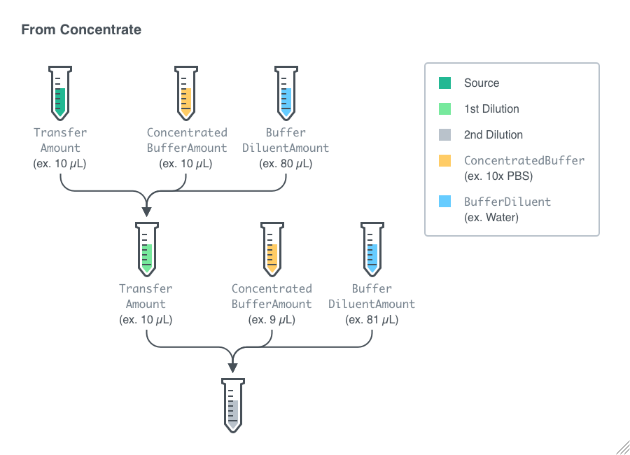
Figure 1.3: A specified or calculated amount is transferred from the input sample to a container with specified or calculated amounts of BufferDiluent, and optionally, a ConcentratedBuffer. After mixing, another amount is transferred from the second container to a third container with a specified amount of BufferDiluent and optionally ConcentratedBuffer, and the process repeats until the desired number of dilutions is reached. The BufferDiluent here is meant to dilute the ConcentratedBuffer at each step. In this example, the sample is being diluted by factors of 10 twi times, where the BufferDiluent is water and the ConcentratedBuffer is 10X PBS.

Instrumentation

Super STAR

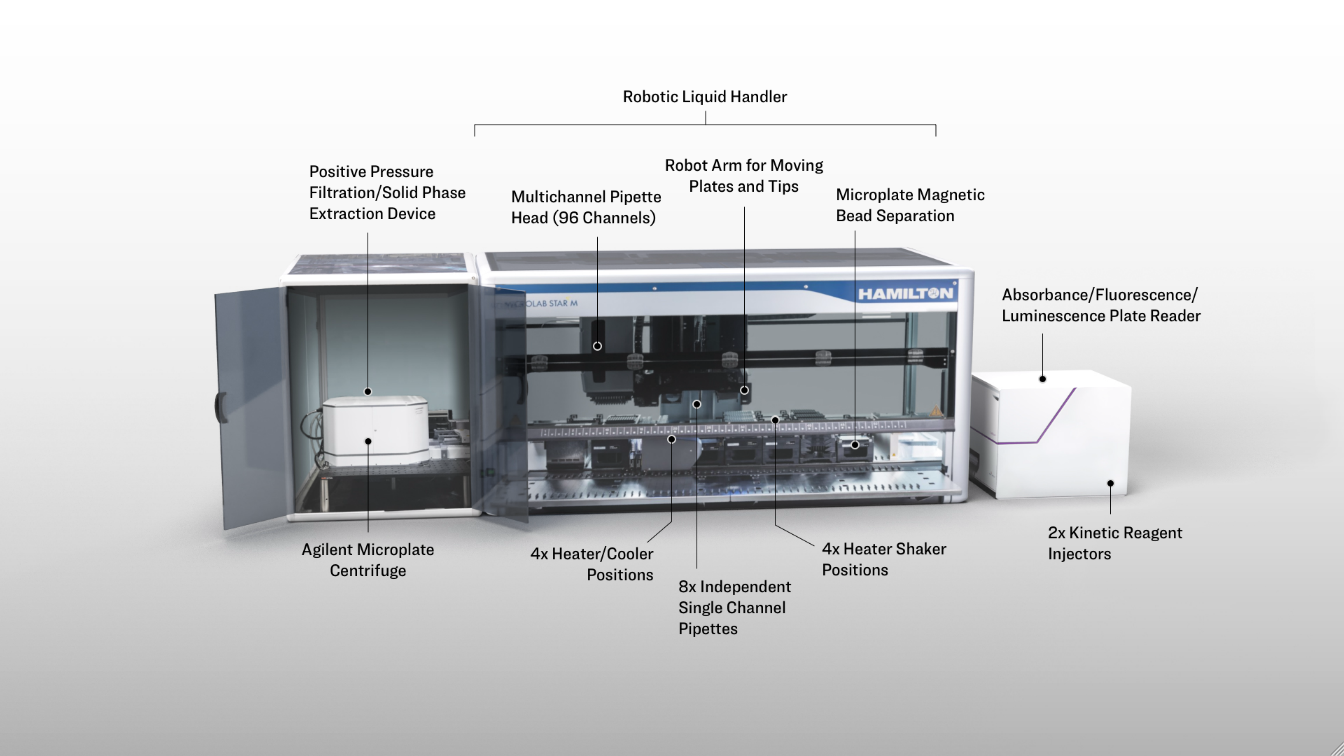
Figure 2.1.1: An overview of the robotic workcell. It is capable of processing plate operations including incubation, shaking, and magnetic bead separation on-deck and centrifugation, filtration, and absorbance/fluorescence/luminescence measurement off-deck, with a robot arm facilitating the plate movements.
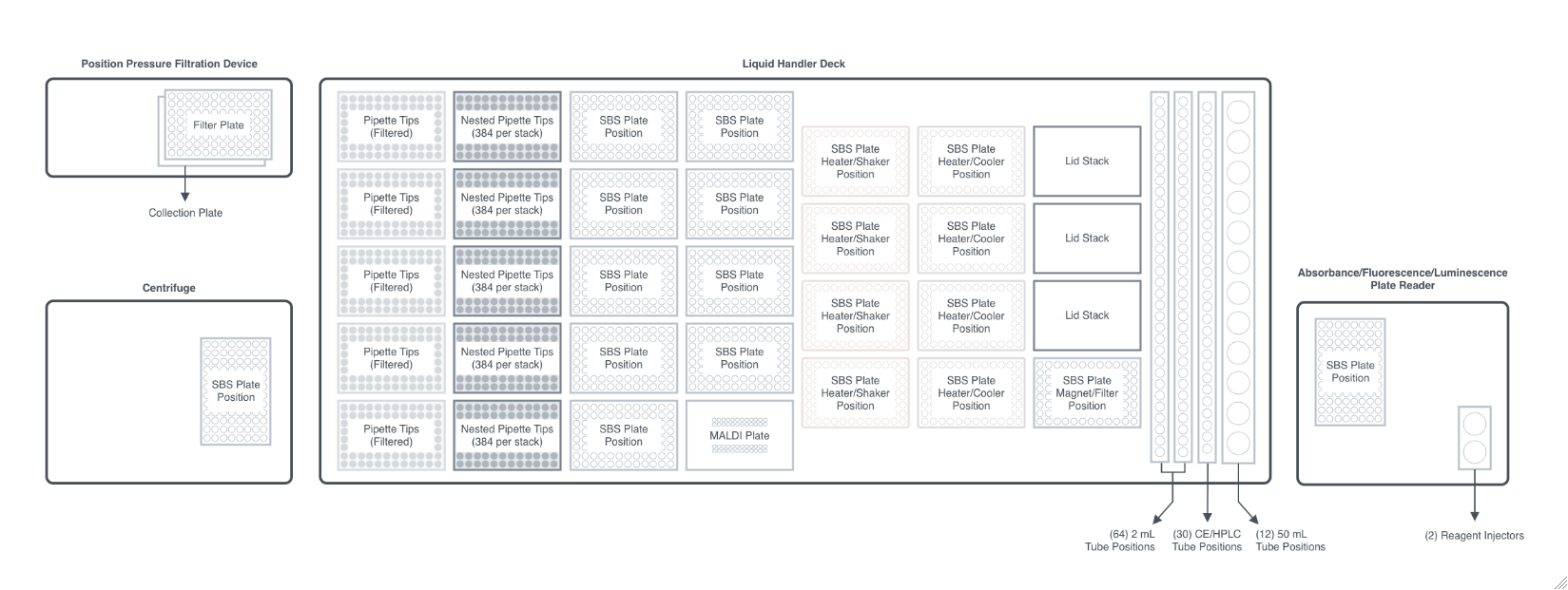
Hamilton STARlet

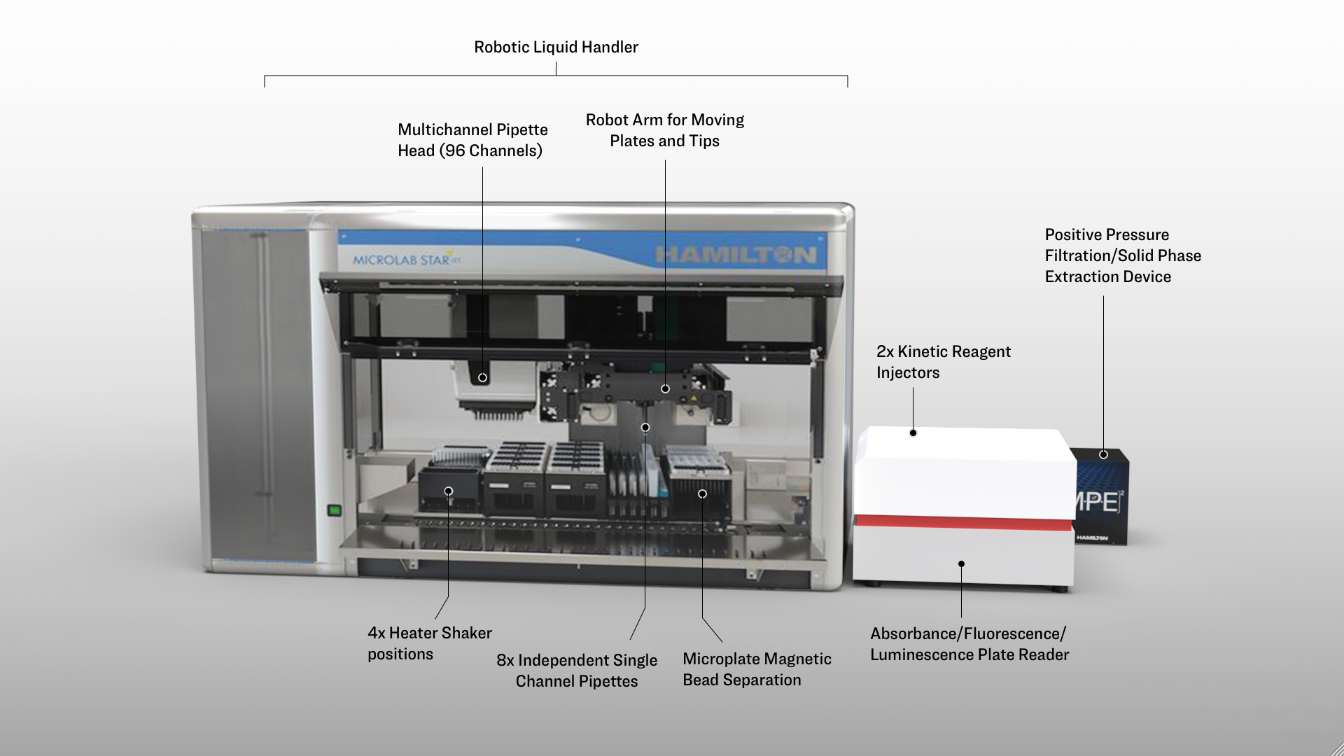
Figure 2.2.1: An overview of the robotic workcell. It is capable of processing plate operations including incubation, shaking, and magnetic bead separation on-deck and filtration and absorbance/fluorescence/luminescence measurement off-deck, with a robot arm facilitating the plate movements.
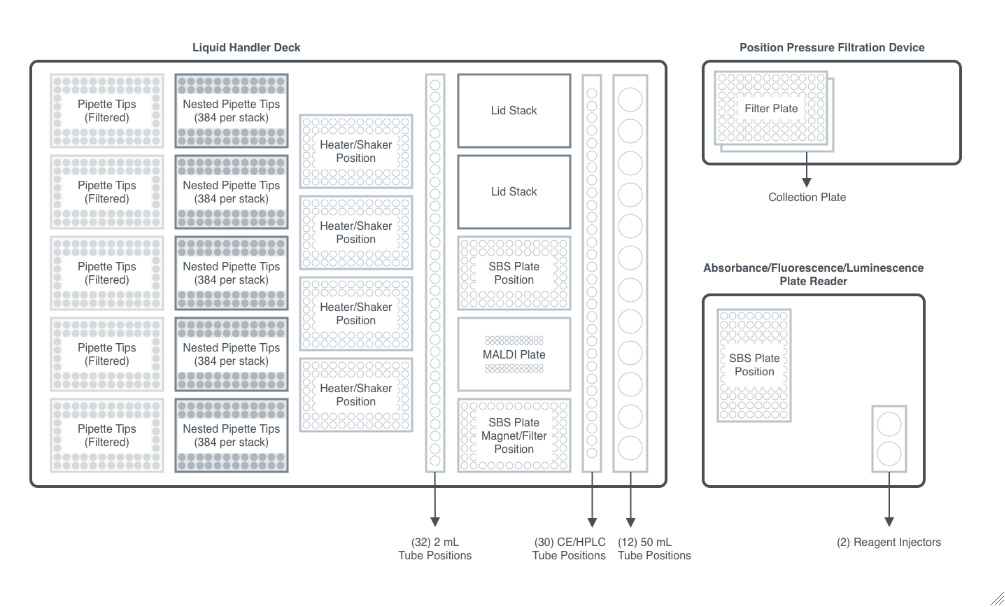
Eppendorf Research Plus P200

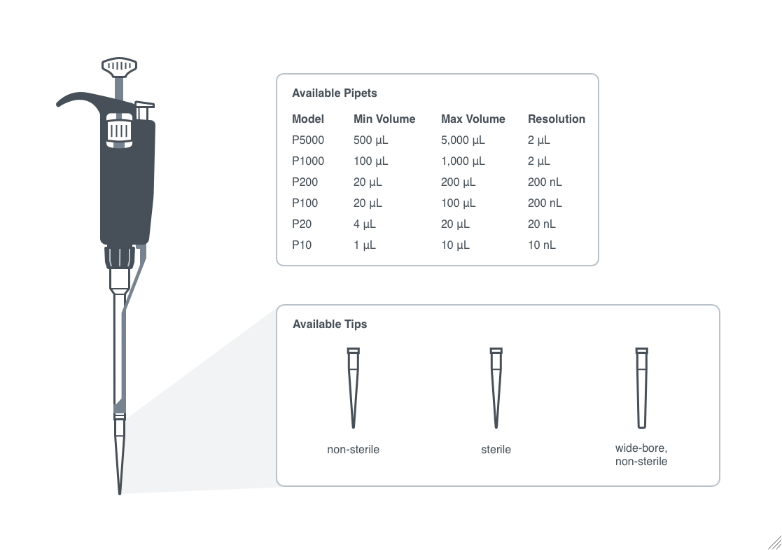
Figure 2.3.1: The diagram above lists the available pipette sizes and corresponding tip types that are available in the ECL.
pipetus

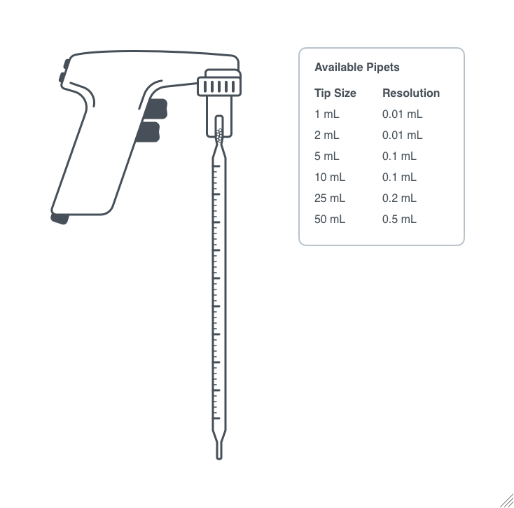
Figure 2.4.1: The above diagram lists the compatible serological tip sizes that are available at the ECL.
Eppendorf Research Plus, 8-channel 1200uL

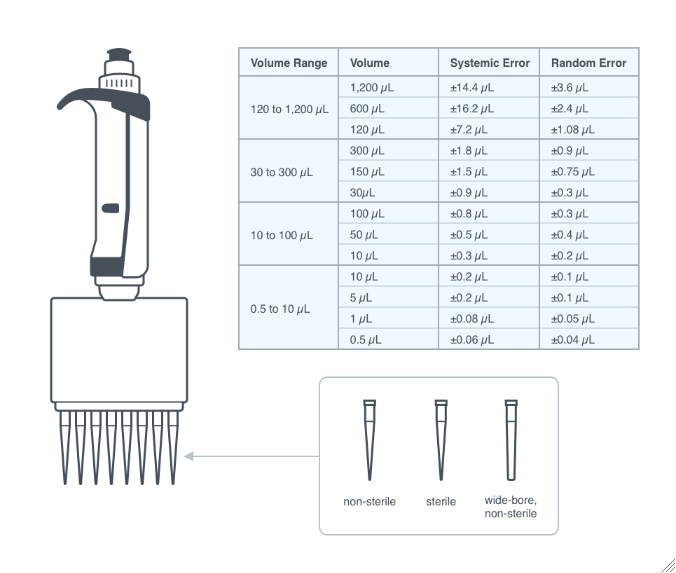
Experiment Options
General
Source
Pattern Description: An object of type or subtype Object[Sample] or Object[Container] or a prepared sample.
SourceLabel
SourceContainerLabel
SampleOutLabel
ContainerOutLabel
DiluentLabel
ConcentratedBufferLabel
The label of the concentrated buffer that is diluted by the BufferDilutionFactor in the final solution (i.e., the combination of the sample, ConcentratedBuffer, and BufferDiluent).
BufferDiluentLabel
The label of the buffer used to dilute the sample such that ConcentratedBuffer is diluted by BufferDilutionFactor in the final solution.
SerialDilutionFactors
The factors by which you wish to reduce the concentrations starting with SamplesIn, followed by each previous dilution in the series of dilutions. This or TargetConcentrations must be provided, or an error is thrown.
NumberOfSerialDilutions
The number of times the sample is repeatedly diluted, starting with SamplesIn, followed by each previous dilution.
Default Calculation: Automatically set to the number of TargetConcentrations or SerialDilutionFactors if provided, otherwise set to 1.
Analyte
The components in SamplesIn's Composition whose final concentrations (TargetConcentrations) are attained through a series of repeated dilutions.
Default Calculation: Automatically set to the first value in the Analytes field of SamplesIn, or, if not populated, to the first analyte in the Composition field of the input sample, or if none exist, the first identity model of any kind in the Composition field.
Pattern Description: An object of type or subtype Model[Molecule], Model[Molecule, cDNA], Model[Molecule, Oligomer], Model[Molecule, Transcript], Model[Molecule, Protein], Model[Molecule, Protein, Antibody], Model[Molecule, Carbohydrate], Model[Molecule, Polymer], Model[Resin], Model[Resin, SolidPhaseSupport], Model[Lysate], Model[ProprietaryFormulation], Model[Virus], Model[Cell], Model[Cell, Mammalian], Model[Cell, Bacteria], Model[Cell, Yeast], Model[Tissue], Model[Material], or Model[Species] or Null.
BufferDilutionStrategy
BufferDilutionStrategy describes the manner in which to generate to buffer samples for each serial dilution. FromConcentrate provides ConcentratedBuffer to each well, which is then diluted with BufferDiluent to reach a final buffer concentraion of 1X, whereas Direct uses pre-diluted buffer which is already at 1X to perform the subsequent dilutions (see Equations chart in Process Diagrams).
TransferAmounts
Pattern Description: List of one or more greater than or equal to 0 microliters and less than or equal to 20 liters entries.
Diluent
Default Calculation: Automatically set to the Solvent of SamplesIn, or Model[Sample,"milli-Q Water"] if Solvent is not defined.
Pattern Description: An object of type or subtype Object[Sample] or Model[Sample] or a prepared sample or Null.
Programmatic Pattern: ((Null | (ObjectP[{Object[Sample], Model[Sample]}] | _String)) | Automatic) | Null
DiluentAmount
The amount of solution used to reduce the concentration of the SamplesIn and each subsequent dilution.
Pattern Description: List of one or more greater than or equal to 0 microliters and less than or equal to 20 liters entries.
BufferDiluent
The solution used to reduce the concentration of the ConcentratedBuffer in the first and each subsequent dilution.
Default Calculation: If the BufferDilutionStrategy is Direct, it will be set to Null. If not, it will automatically be set to the Solvent of ConcentratedBuffer, or Model["milli-Q Water"] if Solvent is not defined.
Pattern Description: An object of type or subtype Object[Sample] or Model[Sample] or a prepared sample or Null.
BufferDilutionFactor
The factor by which to reduce the concentration of the ConcentratedBuffer (but not the input sample) in all of the dilutions.
Default Calculation: Automatically set to the ConcentrationFactor of ConcentratedBuffer. If ConcentrationFactor is not defined, automatically set to 10 and throws a warning.
BufferDiluentAmount
The amount of buffer diluent to be added to reduce the concentration of ConcentratedBuffer in each dilution.
Pattern Description: List of one or more greater than or equal to 0 microliters and less than or equal to 20 liters entries or Null.
ConcentratedBuffer
The buffer used in the first dilution from SamplesIn. If BufferDiluentStrategy is FromConcentrate, then it will also be used in subsequent dilutions.
Pattern Description: An object of type or subtype Object[Sample] or Model[Sample] or a prepared sample or Null.
ConcentratedBufferAmount
The amount of ConcentratedBuffer used in the first dilution from SamplesIn and each subsequent dilution.
Pattern Description: List of one or more greater than or equal to 0 microliters and less than or equal to 20 liters entries or Null.
DiscardFinalTransfer
Indicates if the final wells contain the same volume as the previously diluted wells by removing TransferAmount from the final dilution.
ContainerOut
The desired type of container that should be used to prepare and house the diluted samples, with indices indicating grouping of samples in the same plates, if desired.
Default Calculation: Automatically set as the PreferredContainer for the AssayVolume of the sample. For plates, attempts to fill all wells of a single plate with the same model before diluting into the next.
Pattern Description: List of one or more an object of type or subtype Model[Container] or Object[Container] or a prepared sample entries or list of one or more {Index, Container} entries.
Programmatic Pattern: ({(ObjectP[{Model[Container], Object[Container]}] | _String)..} | {{GreaterEqualP[1, 1] | Automatic, (ObjectP[{Model[Container], Object[Container]}] | _String) | Automatic}..}) | Automatic
TargetConcentrations
Default Calculation: In either Direct or FromConcentrate, can be calculated from the equations in Process Diagrams.
Pattern Description: List of one or more greater than 0 molar or greater than 0 grams per liter entries or Null.
Programmatic Pattern: ((Null | {(GreaterP[0*Molar] | GreaterP[(0*Gram)/Liter])..}) | Automatic) | Null
FinalVolume
The final volume in each well after the series of dilutions. This must be provided, or else an error is thrown.
Default Calculation: In either Direct or FromConcentrate, can be calculated from the equations in Process Diagrams.
Pattern Description: List of one or more greater than or equal to 0 microliters and less than or equal to 20 liters entries.
DestinationWells
Preparation
Indicates if this unit operation is carried out primarily robotically or manually. Manual unit operations are executed by a laboratory operator and robotic unit operations are executed by a liquid handling work cell.
Mixing
TransferMix
TransferMixType
Default Calculation: Automatically set based on the Volume option and size of the container in which the sample is prepared.
TransferNumberOfMixes
Determines the number of times the sample is mixed for discrete mixing processes such as Pipette or Swirl.
Incubate
IncubationTime
Default Calculation: Automatically set to 30 minutes unless MixType is set to Pipette or Invert, in which case it is set to Null. Note that if you are mixing AND incubating and this option is specified, it must be the same as the specified value of the IncubationTime option.
Pattern Description: Greater than or equal to 0 hours and less than or equal to 72 hours or Null or Null.
MaxIncubationTime
Default Calculation: Automatically set based on the MixType if MixUntilDissolved is set to True. If MixUntilDissolved is False, resolves to Null.
Pattern Description: Greater than or equal to 1 second and less than or equal to 72 hours or Null or Null.
Incubation
IncubationTemperature
Default Calculation: Automatically set to the maximum temperature allowed for the incubator and container, or Null if Incubate is set to False.
Pattern Description: Ambient or greater than or equal to -20 degrees Celsius and less than or equal to 500 degrees Celsius or Null or Null.
Programmatic Pattern: ((Null | (Null | (RangeP[$MinIncubationTemperature, $MaxIncubationTemperature] | Ambient))) | Automatic) | Null
Post Experiment
SamplesInStorageCondition
The non-default conditions under which the SamplesIn of this experiment should be stored after the protocol is completed. If left unset, SamplesIn will be stored according to their current StorageCondition.
Pattern Description: {AmbientStorage, Refrigerator, Freezer, DeepFreezer, CryogenicStorage, YeastIncubation, BacteriaIncubation, MammalianIncubation, TissueCultureCellsIncubation, MicrobialCellsIncubation, MicrobialCellsShakingIncubation, YeastCellsIncubation, YeastCellsShakingIncubation, ViralIncubation, AcceleratedTesting, IntermediateTesting, LongTermTesting, UVVisLightTesting} or Disposal or Null.
SamplesOutStorageCondition
The non-default conditions under which any new samples generated by this experiment should be stored after the protocol is completed. If left unset, the new samples will be stored according to their Models' DefaultStorageCondition.
Pattern Description: {AmbientStorage, Refrigerator, Freezer, DeepFreezer, CryogenicStorage, YeastIncubation, BacteriaIncubation, MammalianIncubation, TissueCultureCellsIncubation, MicrobialCellsIncubation, MicrobialCellsShakingIncubation, YeastCellsIncubation, YeastCellsShakingIncubation, ViralIncubation, AcceleratedTesting, IntermediateTesting, LongTermTesting, UVVisLightTesting} or Disposal or Null.
Protocol Options
Post Experiment
MeasureWeight
Indicates if any solid samples that are modified in the course of the experiment should have their weights measured and updated after running the experiment. Please note that public samples are weighed regardless of the value of this option.
MeasureVolume
Indicates if any liquid samples that are modified in the course of the experiment should have their volumes measured and updated after running the experiment. Please note that public samples are volume measured regardless of the value of this option.
ImageSample
Warnings and Errors
-
Messages
Last modified on Thu 13 Jan 2022 14:51:58
